
Mayan History is on Display at Lake Atitlan Guatemala
By Mary Hammerbeck
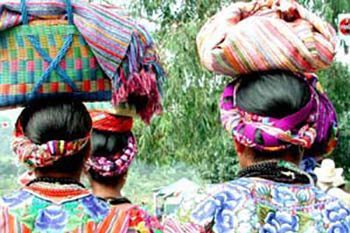
The ancient, craterous Lake Atitlán Guatemala is, for many travelers, the best way to be introduced to indigenous culture in the highlands of Western Guatemala.
At the depths of volcanic slopes, the lake spreads out for miles. Its shores reach for and nurture nine lakeside communities.
Panajachel, Santa Cruz, San Marcos, San Juan, San Pedro, Santiago, San Lucas, Jaibalito, and San Antonio Palopó have depended on Atitlán as children depend on their mothers; the lake — with its geographically isolated pueblos — provides a safe-haven for indigenous culture. The existing Mayan communities depend upon this.
Traveling northwest of Guatemala City, Panajachel (the largest of the lakeside pueblos) is a four-hour bus trip leading to the country’s western highlands. The Rebuli bus station on 21st street and 1-34 Avenue (Zone 1) in Guatemala City leaves every day at 6, 9, and 10 a.m. for Panajachel.
Panajachel on Lake Atitlan
The trip is a jostling ascent into the highlands until the lake comes into view at the bottom of a volcanic mountain range. At that point, the ride takes an ear-popping turn to the end of the line in the small city of Panajachel — the most well-known access to Lake Atitlan.
Before the descent, though, the bus will pass through Los Encuentros, the pueblo that serves as an open gate to the western highlands of Guatemala; various paths of travel intersect here, and the roadside pueblo can be identified by its busy pace and sidewalk-flanking vendors.

At this gate, a new traveler begins to recognize one of Guatemala’s most defining and exquisite aspects: the prominent indigenous culture. The ascent reveals Mayan history intact in traditional dress, handicrafts, and dialect.
The mountains have made homes for the indigenous Guatemalans as far as time stretches back; this natural placement sustains and offers surprising resilience to the Mayan heritage and way of life.
As tourists, we are wide-eyed with aesthetic delight in witnessing this. Daughters are tiny versions of their mothers in embroidered blouses and woven skirts while the older generation of men boldly presents themselves in white pants, broad embroidered belts, and colorful mountain shirts.
The colors are so grand! And they only brighten as you further explore the communities of Lake Atitlán.
Mayan Handicrafts
Panajachel is a tourist center for foreigners and the largest and most accommodating of Atitlán’s lakeside pueblos. The tourist market is a seven-day display of Mayan handicrafts, hand-woven blankets, tapestries, and clothing.
Indigenous families from Panajachel and surrounding areas sell their artwork along the principal street in town. The traffic of the markets lends business to the team of restaurants, hotels, and guide services in Panajachel that host the various needs of backpackers, upscale travelers, and weekend getaways for wealthier Guatemalan families.

Panajachel’s economy is a prime example of the influence of tourism in Guatemala. Ancient traditions of the Mayan people are recognized as moneymakers and are paradoxically preserved through the selling of handicrafts.
The market and accommodating businesses exhibit western influence in an otherwise culturally preserved land.
Additionally, the growing presence of foreigners as residents has greatly influenced business here. Panajachel, along with the other lakeside pueblos, hosts a community of foreign residents who occupy the most lakefront property.
Hostels and restaurants run by foreigners shamefully deny shoreline access to locals while attracting tourists with creative themes and lavish flower gardens (any horticulturist’s dream).
While these accommodations provide a beautiful respite for travelers, the unspoken illegitimacy of their presence is another awkward and sad contradiction that plagues Guatemala.
An Interesting Niche
These changes have carved out an interesting niche in the villages of Lake Atitlán: the indigenous people practice self-preservation through business dealings with tourists. The native culture miraculously survives amidst this traffic, in part by turning their tradition into the product.
It is a curious contradiction in the face of western influence upon small, indigenous communities. The confusion that manifests here can best be captured in the name that Guatemalans commonly use to refer to Lake Atitlán — “Gringotenango.” The suffix, -tenango is Mayan for “the place of,” while we all know what gringo means!
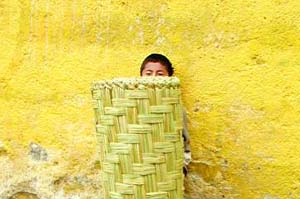
The small pueblos of Santa Cruz, San Marcos, San Juan, San Pedro, Santiago, San Antonio Palopó, and Jaibalito are different from Panajachel in that the tourist industry is isolated to the lakefront while entire communities remain separated from it.
For the traveler whose curiosity persists beyond market trinkets and accommodating abodes, it is worth a trip across the lake to the intricate communities of Lake Atitlán, Guatemala. Some pueblos are accessible only by boat — making them even more intriguing.
If you take a boat from Panajachel to Santa Cruz, San Marcos, or San Pedro, your first impression will be of cartoonesque signs and streets directing you to a jumble of accommodations — most of which are owned by foreigners.
True Local Living
There won’t be a sign that says, “Welcome to Gringotenango.” However, you can’t miss it. But beyond that, and usually at a higher elevation due to the steep slope of the mountain range, exists a beautiful network of true local living.
Panaderías (bakeries), supply stores, local markets (best for produce!), and comedores (small eateries) represent an independent economy, and the way of life goes on without tourists. It is absolutely enchanting.
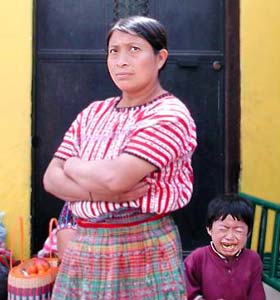
A certain gentleness settles like an aura around these communities. Observing their lives feels like watching a giant smile spread across a child’s face.
Kindness, generosity, family values, hard work, and a simple understanding for the place and history is as much engrained in the steep, maze-like towns as are the rock foundations, the cobblestone streets, the trusty mountain earth.
Spreading avocado on fresh bread with your pocket knife, curbside, the blooming-flower action of the pueblo before you, this could be all you need.
Lodging
San Pedro — the lakeside hotspot for recreational respite — is a straight shot across the lake from Panajachel (about a 30-minute trip and 15 quetzales/$2.00US).
International cuisine, a variety of low-budget hostels, kayak rentals, movie showings, yoga classes, bookstores, nighttime hangouts offer affordable extravagance to the hardcore backpacker (or a final destination for the relaxation seekers).
The main street is flanked with these businesses, but any dirt-paved trail will lead you to a new restaurant, hostel, or bar. At that point, the choice is yours.
Casa Elena is the most popular hostel located right on the lake. Cheap rooms (about 40 quetzales/$5.00US/night), swimming and sunset viewing access, locally owned by a friendly Mayan family, and cleanliness ensure that you really can’t beat this place.
Otherwise, Trippie’s or Hotel San Francisco offer even cheaper deals (see below for details).
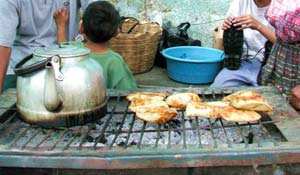
Eats
For eating, Munchie’s offers a great vegetarian menu, Nick’s Place has authentic Guatemalan food, The Creperie is run by a talented French gentleman, and La Casa Mexicana features straight-up Mexican cuisine. All restaurants run around the same price range (about 30Q a plate).
With no real street system in this part of town, places are found by wandering around seeming endless dirt paths. Kayak rentals for lake exploration are located on the lakeshore on the far east side of town and should cost about 25Q/day.
While using a kayak, it may be worth it to zip across the lake to San Marcos — the yoga retreat and emotional healing hub of Guatemala. A strange niche, it attracts travelers seeking a certain relaxation (the kind that involves intensive five-week courses on replenishing the soul).
Many visitors slip in for a weekend of massage and hammock lounging, but this subculture is mostly sustained by people who share an alternative spirituality and who communally root themselves here. With wild spiritualists coming together from across the globe, San Marcos guarantees an interesting experience.
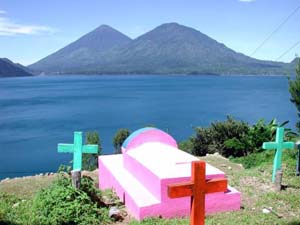
A Step Toward Normalcy
Santa Cruz is a step toward normalcy in comparison to San Marcos. Yet, the three communally-run hostels here maintain a “hippie” feel and relaxation is practically the only option. Great food, music, and conversation with travelers are what this place is about.
Yet again, the pueblos of San Marcos and Santa Cruz that rest at a higher altitude from the lake marks the stark differences between tourists and the indigenous, and local living (with all its hardships) persists above the hum of indulging travelers.
Places like Santiago and San Lucas offer little to the tourist community in terms of accommodations, but the markets of Santiago offer the widest array of goods in all of Lake Atitlán. This is the place to come for weavings and a more accurate insight into Guatemalan culture.
A Means of Survival
It is through the eyes of business dealings that you can if you dare to, see your presence as a traveler for what it is: a means of survival for threatened native communities.

Stronger than the influence of tourism on Guatemala, the people of Atitlán insist upon living alongside the lake as they have throughout history. They have only been forced to provide for us what we’ve come looking for.
As we appreciate the beauty of their culture in our way, we should remember that the depth of tradition lies in heritage and sense of place—a depth we cannot truly see, like that which stretches from the tops of ancient volcanoes to the imagined and mysterious lake floor.
Suggested Accommodations in Panajachel
Posada Monte Rosa
Calle Monte Rey
US $12 per night (single)
Telephone 762-0055
Villa Lupita
Callejón Don Tino
US $5 per night (single)
Telephone 762-1201
Hotel Primavera
Calle Santander
US $20 per night (single)
Telephone 762-2052

Suggested accommodations in San Pedro
Casa Elena
7th avenue in Zone 2 (closest avenue to the boat dock from Panajachel, lakefront)
US $5 per night (single)
No phone or email, but easy to find!
Hotel San Fransisco
5th Avenue in Zone 3 (near ferry dock to from Santiago)
telephone 721-8016
(offers kitchen, hot water, lake view from patio)
Trippie´s Hostel
No official contact information, but easy to find it´s obscure hideaway by asking around
US $3 per night (single) (offers kitchen, hot water, an all-female dorm)
Suggested accommodations in San Marcos
Hotel El Unicornio
Lakefront location
US $5 per night (single)
website
(offers kitchen, hot water, sauna)
Posada Schumann
Lakefront location
US $15 per night (single)
(offers kitchen, rooms or cottages, hot water, sauna)
Suggested accommodations in Santa Cruz
La Iguana Perdida
Lakefront location
US $3-12 per night (dorm, single, or double)
Laiguanaperdida@itelgua.com
(offers prepared communal meals for about $5 for dinner, bar, open-air dorm beds)
La Casa Rosa Hotel
Lakefront location
US $5-15 per night (rooms or bungalows)
(offers restaurant, bar, sauna)
 Mary Hammerbeck has lived and traveled throughout Central and South America and has volunteered as an English teacher in Santa Rosa, Guatemala, and Quito, Ecuador. A graduate of Northland College in Wisconsin, she has been published in FOCUS magazine and Transitions Abroad magazine.
Mary Hammerbeck has lived and traveled throughout Central and South America and has volunteered as an English teacher in Santa Rosa, Guatemala, and Quito, Ecuador. A graduate of Northland College in Wisconsin, she has been published in FOCUS magazine and Transitions Abroad magazine.
- Missouri Sports Travel Adventure: From Landmarks to Ballparks - January 21, 2026
- What First-Time Visitors Get Wrong About Visiting Iceland - January 15, 2026
- Bareboat Charter vs all-inclusive Crewed: Which Luxury Charter Fits You? - December 29, 2025


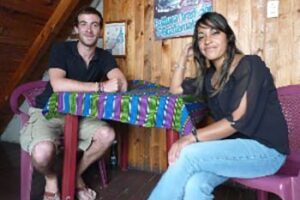

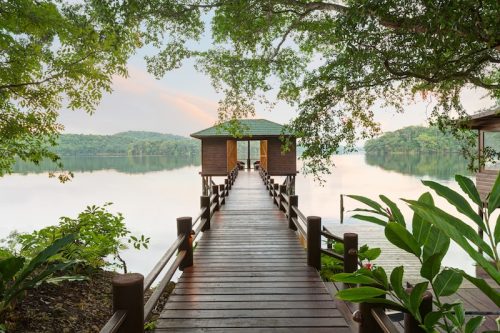

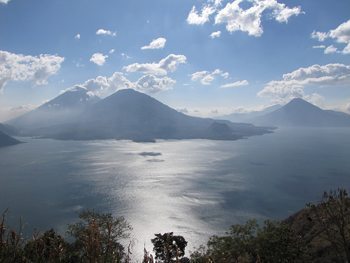

I lived in Panajachel for the past three years and find this article to be fairly accurate. It’s disappointing, though, to see hotel Casa Palopo as the lead picture – the place is extremely expensive and their food is not very good! Also, boat fare across the lake is 25 quetzales, has been for some time. I encourage visitors to not haggle over prices with the Mayan artisans as their handcrafts are time consuming to make. If anything, give them a bit more than they ask.
check out Islaverde, Santa Cruz. best hotel (eco-resort) with the best food in the area